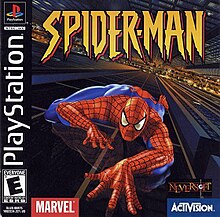
Carnage is a supervillain appearing in American comic books published by Marvel Comics, usually as an adversary of Spider-Man and the archenemy of Venom, in particular the Eddie Brock incarnation of the character, although Carnage and Venom would join forces if their goals aligned. The character made its first appearance in The Amazing Spider-Man #361, and was created by writer David Michelinie and artist Mark Bagley, although the first published artwork of Carnage was penciled by Chris Marrinan.

Donald Duck: Goin' Quackers is a platform video game developed and published by Ubi Soft for various consoles and Windows-based personal computers. A different game with the same title was first released for the Game Boy Color, as well as on Game Boy Advance, the latter being given the title Donald Duck Advance.
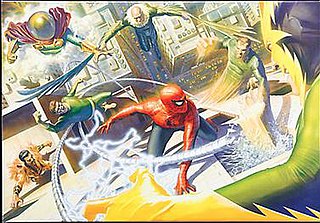
The Sinister Six are a group of supervillains appearing in American comic books published by Marvel Comics, mainly those featuring Spider-Man. The members are drawn from the character's list of enemies, with the original members forming the team in The Amazing Spider-Man Annual #1. Led by Doctor Octopus, the team in its premiere followed swiftly the very early appearances of many of the most enduring members of Spider-Man's rogue's gallery: Vulture, Sandman, Electro, Mysterio, and Kraven the Hunter. While Doctor Octopus has generally remained its leader, the Sinister Six has had multiple variations of composition.

Ultimate Spider-Man is a 2005 action-adventure game based on the Marvel Comics character Spider-Man and the comic book of the same name. The game was published by Activision for the Windows, GameCube, PlayStation 2, Xbox, Nintendo DS, Game Boy Advance. The PlayStation 2, GameCube and Xbox versions were developed by Treyarch and are drastically different from the handheld versions, which were developed by Vicarious Visions. The Windows version is a port of the home console versions, developed by Beenox. A version for mobile phones was also developed and published by Mforma. A Limited Edition of the game was released for the PlayStation 2, and includes additional content such as a "making of" documentary and an interview with Spider-Man co-creator Stan Lee.

Ms. Pac-Man Maze Madness is a maze chase video game developed and published by Namco for the PlayStation in 2000. It was later released for the Nintendo 64, Dreamcast, and Game Boy Advance. A remake of Ms. Pac-Man (1982), players control the titular character in her quest to stop a witch named Mesmerelda from stealing the Gems of Virtue. The game was well-received upon release, with critics applauding its simplicity and faithfulness to the arcade original. A sequel was in development around 2006, but was cancelled for unknown reasons.

Spider-Man and Venom: Maximum Carnage is a side-scrolling beat 'em up game for the Super Nintendo Entertainment System and Mega Drive/Genesis, developed by Software Creations and published by Acclaim Entertainment and its subsidiary LJN in 1994. The game, based on the comic book story arc of the same name, features numerous heroes, including Spider-Man, Venom, and their allies from the Marvel Comics fictional universe like Captain America, Black Cat, Iron Fist, Cloak and Dagger, Deathlok, Morbius and Firestar, all teaming up to battle an onslaught of villains led by Carnage, including Shriek, Doppelganger, Demogoblin and Carrion.
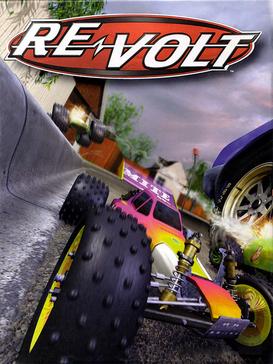
Re-Volt is a racing video game designed by Paul Phippen and Simon Harrison. It was developed by Acclaim Studios London and published by Acclaim Entertainment for Microsoft Windows, Nintendo 64, PlayStation and Dreamcast.
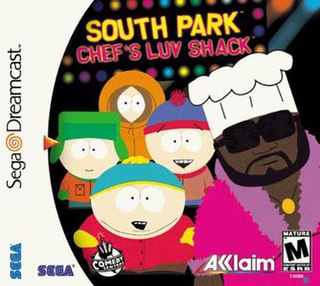
South Park: Chef's Luv Shack is a 2D game show-style party video game and is a sequel to the 1998 video game South Park, itself based on the American animated sitcom of the same name. Developed by Acclaim Studios Austin and published by Acclaim Entertainment, it was released in 1999 for the Dreamcast, Microsoft Windows, PlayStation and Nintendo 64. Its gameplay involves playing minigames and the ability to play against other players in a challenge for the most points. It also involves trivia questions about South Park and other topics.

Spider-Man 3 is a 2007 action-adventure game based on the 2007 film of the same name. The game is the sequel to 2004's Spider-Man 2, itself based on the 2004 film of the same name. It was released for the PlayStation 3, PlayStation 2, Xbox 360, Microsoft Windows, Wii, Nintendo DS, and Game Boy Advance on May 4, 2007, and for the PlayStation Portable on October 16, 2007. Published by Activision, the PlayStation 3 and Xbox 360 versions were developed by Treyarch, while Vicarious Visions handled the development of the other versions, which are drastically different. Beenox ported Treyarch's version of the game to Microsoft Windows.

South Park Rally is a 2000 kart-style racing video game based on the American animated sitcom South Park published by Acclaim Entertainment and released for the PlayStation, Microsoft Windows, Nintendo 64, and Dreamcast. Gameplay follows the player in a competitive racing championship set in the fictional town of South Park. Players are given the options for multiplayer, arcade, or championship modes, but only the championship unlocks extra features. Competition begins in South Park's 1st Rally, a circuit race around four checkpoints in the downtown area of South Park. Races get gradually more diverse, with more locations, racers, and elements added as the game progresses.
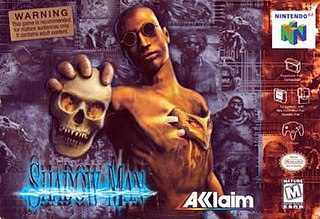
Shadow Man is an action-adventure video game developed by Acclaim Studios Teesside and published by Acclaim Entertainment. It is based on the Shadow Man comic book series published by Valiant Comics. The game was announced in 1997 and was originally slated for a late 1998 release on Nintendo 64 and an early 1999 release for Microsoft Windows, but was delayed to August 31, 1999. A PlayStation version was also released on the same day. A Dreamcast version was released three months later on December 1.

F-1 World Grand Prix, developed by Paradigm Entertainment, is a Formula One racing game/sim first released in 1998 for the Nintendo 64 game console and to later platforms including the Sega Dreamcast, Microsoft Windows, Sony PlayStation, and Game Boy Color. The Nintendo 64 version is based on the 1997 Formula One season, featuring each of the 17 circuits from the season and all 22 drivers, with the exceptions of Jacques Villeneuve and the MasterCard Lola team.

Monaco Grand Prix: Racing Simulation 2, also known as just Monaco Grand Prix or Racing Simulation: Monaco Grand Prix, is a Formula One racing game developed and published by Ubisoft for the Windows, Nintendo 64, PlayStation, and Dreamcast. It was released in 1998–1999. A sequel, Racing Simulation 3, was released in 2002.

Lego Spider-Man is a product range of the Lego construction toy, based on the Marvel Comics character Spider-Man. When the theme first launched in 2002, it was inspired by the Spider-Man film released the same year and was part of the Lego Studios line. Additional sets were released two years later, based on the film's sequel, Spider-Man 2. The theme was discontinued before the release of Spider-Man 3, and the rights were sold to rival Mega Brands, who entered a multi-year licensing deal with Marvel Enterprises, giving them the rights to produce playsets, vehicles, and other building-themed products based upon various Marvel characters for their Mega Bloks toys.
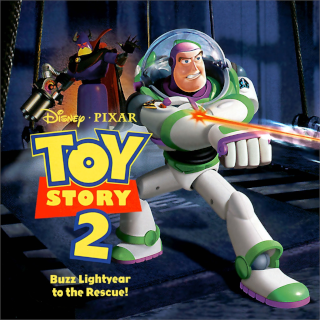
Toy Story 2: Buzz Lightyear to the Rescue! is a platform game developed by Traveller's Tales and published by Activision and Disney Interactive. Based on Disney/Pixar's 1999 computer animated film Toy Story 2, It was released for the Nintendo 64, PlayStation, Microsoft Windows, and Macintosh in late 1999, while a Dreamcast version followed in 2000. The computer versions were released under the title Disney/Pixar's Action Game, Toy Story 2. A different version, a side-scrolling platform game titled Toy Story 2, was also released for the Game Boy Color in 1999.
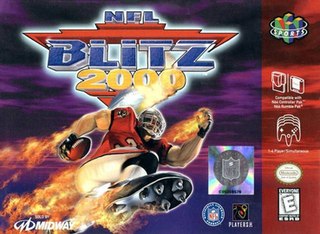
NFL Blitz 2000 is a video game released in the arcades in 1999 and then ported to the PlayStation, Nintendo 64, Dreamcast, Microsoft Windows, and Game Boy Color. It is the third game in the NFL Blitz series.
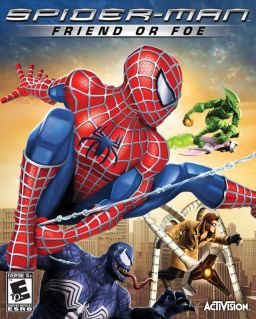
Spider-Man: Friend or Foe is a 2007 action-adventure beat 'em up platform game, based on the Marvel Comics character Spider-Man. The game borrows characters and designs from Sam Raimi's Spider-Man trilogy, with a plot that is non-canon to the films and therefore taking place within a divergent timeline where the villains seen in the films managed to survive. It features two player co-op gameplay, where one player controls Spider-Man and another one of his allies. The storyline of the game revolves around P.H.A.N.T.O.M.s, dangerous creatures created by mixing symbiotes with holographic technology, which a mysterious villain plans to use to take over the world. This villain has also captured and brainwashed many of Spider-Man's foes to help him acquire meteor shards that will strengthen his army. After being recruited by S.H.I.E.L.D., Spider-Man journeys across the globe to retrieve these shards himself and recruit more allies to his cause.
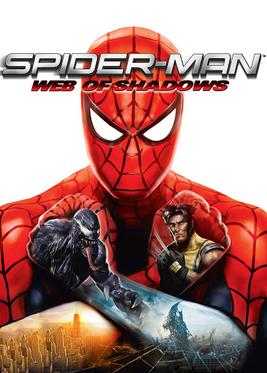
Spider-Man: Web of Shadows is a 2008 action-adventure video game based on the Marvel Comics character Spider-Man. The game was released in October 2008 across multiple platforms, and encompasses three drastically different versions: one released for Microsoft Windows, the PlayStation 3, Wii, and Xbox 360, which features an open world and non-linear gameplay; one for the PlayStation 2 and PlayStation Portable, which is a 2.5D side-scrolling beat 'em up; and one for the Nintendo DS, a Metroidvania-style beat 'em up. All three versions have several common elements, such as moral choices that alter the narrative, the ability to summon allies during fights, and a similar plot, despite different characters being featured. Web of Shadows' storyline is significantly darker than most previous Spider-Man games, as it revolves around a symbiote invasion threatening Manhattan, which Spider-Man must stop with the help of several unlikely allies.

Spider-Man: Shattered Dimensions is a 2010 action-adventure video game based on the Marvel Comics superhero Spider-Man, developed by Beenox and published by Activision. Players control four different versions of Spider-Man, each originating from a different universe in the Marvel Comics multiverse. Previous Spider-Man voice actors Neil Patrick Harris, Christopher Daniel Barnes, Dan Gilvezan, and Josh Keaton each voice one of the four Spider-Men. The Nintendo DS version of the game was developed by Griptonite Games and features only three Spider-Man variants.
